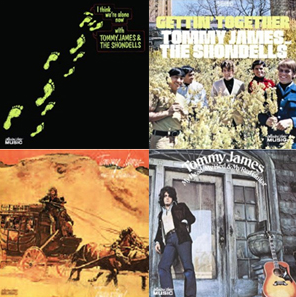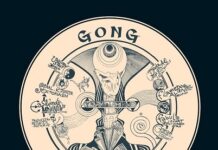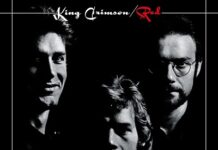All it took was the nudge of a few reissues to make me realize how good Tommy James and The Shondells were. Emerging from the Midwest in the early 60s, the group released over a dozen singles, landed in the Top 10 seven times, and scored two Number Ones. Collectors’ Choice Music is now rolling out the individual Roulette Records albums from Tommy James & the Shondells, as well the odd Tommy James solo release. The first batch includes I Think We’re Alone Now, Gettin’ Together and Travelin’ from the band, plus James’ solo record from 1972, My Head, My Bed &
My Red Guitar.
I Think We’re Alone Now
The tight, sharp strumming and that fantastic Mike Vale staccato bass playing makes Ritchie Cordell’s “I Think We’re Alone Now” a truly a remarkable opener on the 1967 album of the same name. Tommy James’ voice is top notch here, but one tends to forget the players behind the guy. James had recruited a quintet from Pittsburgh to back his early hit “Hanky Panky.” The group changed
their name from the Raconteurs to the Shondells by the time this mega-selling album hit the shelves. “What I’d Give to See Your Face again” sets us back into the 50s with its warbling guitar and even a slightly honky-tonk sounding Ron Rosman piano. “Let’s Be Lovers” follows again with that tight bass playing, some cool snare backbeats, and that aspirated vocal Tommy James can pull off pretty easily, with some slinky but fitting electric guitar.
“Run, Run Baby, Run” chunks along, with Abe Cardwell on harp and a nice, fast pace to the chorus of the highly pitched “run run run baby, run to me”… The title track is of one my favorites of the 12. “Baby Baby (I Can’t Take It No More)” skirts a Burt Bacharach-like arrangements and some of James’ most passionate singing. The two other hits from this album, the goofy “Mirage” with its high whistle key sound and the layered “I Like the Way” (complete with Artie Kaplan’s baritone sax accents), round out the disc. I Think We’re Alone Now was the starting point for the band’s hit making relationship with producers Bo Gentry
and Ritchie Cordell and musical arranger Jimmy Wisner — a relationship that would produce seven gold singles and three gold albums.
Gettin’ Together
Gettin’ Together followed a creative process Tommy James and The Shondells had begun with I Think We’re Alone Now, both released in 1967. Considered a great example of late 60s “sunshine pop,” the by-now powerhouse songwriting and production team of Bo Gentry and Ritchie Cordell and their musical arranger Jimmy “Wiz” Wisner saw Tommy and the boys
in great voice and snappy singable songs.
Though James claims the vocals were sped up to a degree he neither approved of or signed off on, the title track does chunk along with a trilling piano, racing vocals and Beach Boys-like harmonies. It would become the group’s seventh back-to-back gold single as the album was released. “I Want To Be Around You” is a slightly slower Bossa Nova number with James’ voice at a normal pitch. “Some Happy Day” is one of the best tunes here with a solid beat and rich harmonies, similar to those on their 1968 hit “Crimson and Clover.”
“Love’s Closin’ In On Me” features infectious, Hollies-like harmonies, while a handclap backbeat pushes the almost do-whoppin’ “Sometimes I’m Up (Sometimes I’m Down)” and “nah-nah-nahing” of “You Better Watch Out.” Getting away from the light poppy feel, a real gem is “Wish It Were You” with a truly mature lyric that sets it apart from the rest of the songs on Gettin’ Together.
Travelin’
Considered by many to be Tommy James and the Shondells’ finest work, Travelin’ is certainly as rock and roll as the group would ever get. The rockin’ title track opens with some fine Peter Lucia drumming and bass from Mike Vale. At times, about halfway in, we could be listening to King Crimson. Don’t ask me how or why an instrumental with time signature changes opens a Tommy James and The Shondells album, but it works. “Gotta Get Back To You,” was another gold single for the band in all its white funk. “Early In The Mornin'” features a falsetto vocal and a torch song piano from Ron Rosman. Things get downright silly on “Moses & Me.”
The band starts to raise the bar though on tunes like “Kelly Told Anne,” a fantastic Western-like like ballad that stays with the whole concept James had for Travelin’ of “gritty and grainy, like dust in your mouth and sand in your boots.” Things get almost John Lennon-like on the rockin’ “Bloody Water,” with great guitar from Eddie Gray. Listening to “Water,” one tends to wonder where this band might have gone had they survived into the new decade.
We’re back in familiar territory with “Red Rover,” a big harmony popper. “Candy Maker” is the only one with Tommy James on guitar.
“She,” another Top 40 single, harkens back to those big strings and high vocals of the band’s previous hits, but really has no place here. “Talkin’ & Signifyin’,” another boppin’ rocker ends what would be the very last Tommy James and The Shondells album. Travelin’ is a band record through and through. You can certainly hear the cohesiveness of the players
and, as always, Tommy James is in top voice.
My Head, My Head & My Red Guitar
Boppin’ into Nashville to record his 1972 solo album, Tommy James says in the CD’s liner notes of My Head, My Bed & My Red Guitar: “It was the first time in my career that I did album outside of New York City, and I have such wonderful memories associated with the making of the album” Featuring some of the best country music players of the time, like Elvis Presley
sidemen Scotty Moore and DJ Fontana, and Pete Drake, a well-known slide player who also co-produced the record , this is a 13-song collection of Tommy James doing country in a very big way.
Opening with the gospel-like “Nothing To Hide,” James is in fine voice. “Tell ‘Em Willie Boy’s A’ Comin” features note-perfect slide from Drake and fiddle player Buddy Spicher (who is also featured much later in “Forty Days and Forty Nights”). “White Horses” is next, a solid and slinky country number, featuring another strong James vocal, while “Paper Flowers” is vocally cast in the mold of “Crimson and Clover” like with some stand-out bass work from Bob King.
Hee Haw’s The Nashville Addition add some great backing vocals throughout the album, notably on “Forty Days,” “Kingston Highway” (as close as Tommy James was ever gonna get to Elvis) and the spunky “I Live to Love a Woman.” James certainly couldn’t lose with the musicians he had; the only weakness being that some of the songs don’t measure up to the performers’ abilities. My Head, My Bed & My Red Guitar isn’t a bad record by a long shot — it’s just not spectacular, I’m not sure really if James was ready to leave New York for the experiment of My Head, My Head & My Red Guitar, but he was smart enough to surround himself with A-list players to produce a well-executed effort.
~ Ralph Greco, Jr.




















